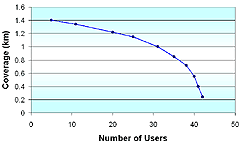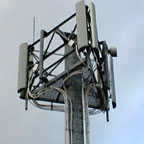Tuesday 15 November, 2005, 07:44 - Spectrum Management
CDMA - Code Division Multiple Access - is probably one of the most complex methods for accessing the radio spectrum that is in use today. Let's first take a look at the easier to understand methods to see what the differences are.FDMA - Frequency Division Multiple Access - is a system whereby different users use different frequencies at the same time. Imagine tuning up and down the FM dial, there are lots of stations you can hear but you can separate one from the other by tuning into the different frequencies that each uses. If two occupy the same frequency at the same time, they cause interference to each other and the whole thing falls to pieces.
TDMA - Time Division Multiple Access - is a system whereby different users use the same frequency at different times. So a number of users messages are scheduled one after the other, so that they can all share the same frequency. Imagine a lot of letters passing along the conveyor belt in a postal sorting office. Each message passes after the other along the same conveyor and can be sorted out back into individual messages for delivery. If two letters were to be in the same place at the same time they would crash into each other and the system would fail. From a radio perspective this works only if you take the message concerned and 'squash' or 'compress' it into less time than it would normally take so that at the receiving end it can be de-compressed to fill in the gap that is produced whilst the other messages are being sent.
CDMA is a system whereby all the users use the same frequency at the same time. How can this possibly work without interference being caused? It works by assigning each message a unique code. Think of it as assigning each message a different language and then place yourself in a room where you can hear all the messages together - the one you immediately understand is the one in the language you speak. So if you hear 'Je m'appelle Colin', 'Ich heisse Lyon' and 'My name is Derek', all spoken at the same time, the clearest message is the one in your native language. However this only works if all the messages are roughly the same volume (and in fact works best if all the messages are exactly the same volume), if one language is shouted a lot louder than the others, it inevitably swamps the listener so that he can no longer hear his natural language.
As such, one element of a CDMA radio system is that the receiver (listener) needs to inform all the transmitters (speakers) how strong their signal is (how loud they are being heard) so that the transmitters can adjust their transmitter power (volume) to allow the receiver to hear them all at the same strength. This system of 'power control' is one of the key technologies that allows CDMA systems to operate.
 CDMA receivers also suffer from something called 'cell breathing'. Imagine that you can hear 4 different languages, the chances are that you will hear the one you understand quite easily. Now imagine you can hear 64 languages, it becomes much more difficult to hear your native language. So the more transmitters sharing the same frequency, the harder the receiver has to listen. To compensate for this, receivers move closer together and further apart each and every second to make sure that they are sufficiently near to those transmitters they are receiving to hear them well. Clearly this is not possible and what happens is that the coverage of the cell shrinks when it is heavily loaded, complicating coverage planning.
CDMA receivers also suffer from something called 'cell breathing'. Imagine that you can hear 4 different languages, the chances are that you will hear the one you understand quite easily. Now imagine you can hear 64 languages, it becomes much more difficult to hear your native language. So the more transmitters sharing the same frequency, the harder the receiver has to listen. To compensate for this, receivers move closer together and further apart each and every second to make sure that they are sufficiently near to those transmitters they are receiving to hear them well. Clearly this is not possible and what happens is that the coverage of the cell shrinks when it is heavily loaded, complicating coverage planning.All this being said, CDMA is reckoned to be around twice as spectrally efficient as either TDMA or FDMA techniques, meaning twice as much traffic (data) can be carried in a given amount of spectrum.
 It is no surprise, therefore, that all of the competing third generation (3G) mobile phone technologies use CDMA: the US-based CDMA-1x series of specifications designed by Qualcomm; the European W-CDMA (Wideband-CDMA) or UMTS (Universal Mobile Telecommunications System) system; and the Chinese TD-SCDMA (Time Division-Synchronised CDMA) system.
It is no surprise, therefore, that all of the competing third generation (3G) mobile phone technologies use CDMA: the US-based CDMA-1x series of specifications designed by Qualcomm; the European W-CDMA (Wideband-CDMA) or UMTS (Universal Mobile Telecommunications System) system; and the Chinese TD-SCDMA (Time Division-Synchronised CDMA) system.What's interesting is that although all 3G mobile technologies use CDMA, other mobile technologies (such as Digital Audio Broadcasting, Wireless LAN and HiperLAN) have forgone the use of CDMA and instead use another spectrum access technique called OFDM - Orthogonal Frequency Division Multiplex. But that's a story for another day.
add comment
( 1446 views )
| permalink
| 



 ( 2.9 / 8845 )
( 2.9 / 8845 )




 ( 2.9 / 8845 )
( 2.9 / 8845 )

